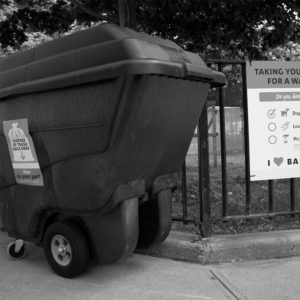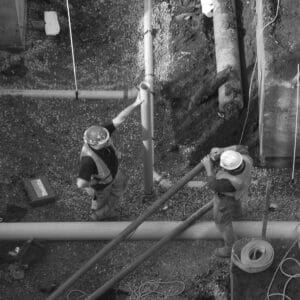Waste Disposal Infrastructure in Public Housing
HIGHLIGHTS
- Buildup of excess trash due to improper disposal is common across NYCHA developments
- Trash buildup creates health and safety concerns, and negative (and false) perceptions about residents
- Improving infrastructure and using behavioral communications reduced buildup, as detailed in our report
The Challenge
The New York City Housing Authority (NYCHA) is the largest manager of public housing in North America, and provides housing to 1 in 15 New Yorkers. Buildup of excess trash and other waste due to improper disposal is common across NYCHA developments, and creates frustration for residents and housing caretakers, as well as health and safety concerns. It also can also create negative (and false) perceptions about resident behavior and motivations.
To address resident concerns about improper waste disposal, the Mayor’s Office of Criminal Justice (MOCJ) sponsored a partnership with ideas42, NYCHA, and the Research and Evaluation Center at John Jay College. Through this collaboration, we identified barriers that made proper waste disposal challenging and designed solutions to address the barriers.
Our Approach
We spoke with NYCHA residents to understand what was driving the problem and used their feedback to design and test ways to support proper disposal. It became clear that residents did not have a convenient option for proper disposal of standard size trash bags, which did not fit into NYCHA buildings’ trash chutes, and existing guidance was unclear or focused on what not to do.
To meet residents’ needs, ideas42 created the following designs:
- installation of large, moveable trash containers (tilt trucks) and trash cans in convenient locations.
- A package of posters, placed indoors and outdoors, to inform people of the new policy and encourage them to use the new infrastructure.
Results
Providing a new, convenient option for disposing of standard size trash bags reduced hassles associated with proper disposal, and with it the problem of trash build-up. An evaluation of the new trash disposal infrastructure revealed significant decreases in the amount of trash visible at NYCHA developments that received the intervention. Following a four-month randomized controlled trial across 53 NYCHA sites, trash disposal improved across the board:
- The average number of household trash bags left outside decreased by 25%
- The average number of litter pieces on grounds decreased by 16%
- The average instances of identification of dog waste decreased by 11%
Takeaway
These results serve as a proof-of-concept that new resources can measurably change people’s quality of life when they center on lived experiences and are designed in collaboration with communities.
To learn more, read our full report of this work, Trashing Misconceptions about Behavior.
Interested in learning more about our work applying behavioral science to economic justice? Reach out to us at info@ideas42.org or tweet at @ideas42 to join the conversation.









